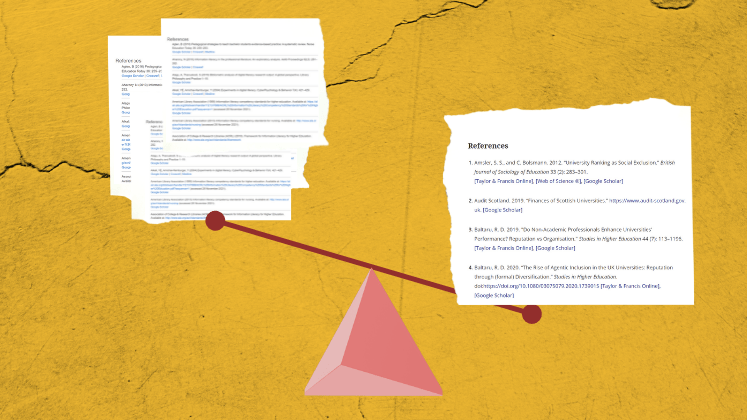We Cannot Cite Our Way to Equality, But Citational Justice Is Vital

They end with a list of cited work, sometimes alphabetical, sometimes numbered. First names are not always included. Authors in the middle of long lists are reduced to “et al.” “They” are the articles, books, reports and other documents we read as researchers. Those lists at the end are important, and they matter. Citations matter. They have politics, create reputations, and make or break scientific careers. A recent Nature article authored by Diana Kwon outlines recent moves to improve “citational justice” for women and minoritized ethnic groups.

Citing, annotating, referencing – these practices are central to all forms of academic work. They are how we join the ongoing conversation of scholars, scientists and researchers, and how we contribute to the accumulation and revision of knowledge. The details of how to cite may vary between countries, disciplines and publishers, but it is a core skill that we all learn in our early days and weeks at university.
As we move from being students to researchers and become more engaged in publishing, citations show with whom we want to connect and in which debates we want to contribute. Citing the work of others demonstrates that we’ve read the literature in our field and acknowledges the intellectual contributions of those who have gone before us. Furthermore, it protects us from committing plagiarism, the great academic sin of taking others’ work as our own.
It is important to pay attention to whom we cite, especially, as there is increasing evidence that women, people of color, and other minoritized groups are systematically under cited (see, for example, Caplar, Tacchella and Birner, 2017; Chakravartty, Kuo, Grubbs and McIlwain, 2018; Fulvio, Akinnola and Postle, 2021). However, citations often hide as much as they identify. For women and people of color, one might have to make assumptions based on first and last names. Evidence about other aspects of identity, including sex and gender diversity, are absent unless authors make it explicit in their work.
We recently produced a guide for the Female Empowerment Maastricht University network (FEM), innocuously called UM Citation Guide, A Guide by FEM. Its aims are however more pointed. We wanted to do something to improve citational justice, to improve the visibility of the contributions to knowledge by all minoritized groups, and to invite colleagues to reflect on their own citational practices.
What can you do to improve the visibility of their contributions to knowledge? In our guide, we provide examples of good practice for different groups. For example, authors are reminded to check whom they quote directly and whom they paraphrase, as the former gives more authority. Students have an important role to play, in reminding their fellow students and their teachers to reflect on gender and other biases in reading lists. Editors and reviewers are reminded to look at some of the guidelines produced by professional associations. For example, the journals of the Biomedical Engineering Society recommend that authors include citation diversity statements.
As an author, you can also consider your own self-citation practices as you tread the fine line between helping readers understand the development of your ideas and coming across as self-promoting and arrogant. Reporting on a study of self-citation, Dalmeet Singh Chawla suggests that men are 56 percent more likely than women to cite themselves.
Citational politics are not simple though, as a series of posts on this blog have discussed. For instance, Nicole Holzhauser has shown how social capital (including gender) shaped the 20th century canon in sociology. Eamon Duede points to how behavioral biases shape citational practices. And Shannon Mason and Margaret Merga provide a healthy reminder that less “prestigious” journals can provide more diverse research. They show us that improving citational justice means looking beyond impact factors for interesting work. Thus, paying attention to citation practices should also be part of the calls for open science.

When writing the citation guide, we were inspired by the “aspirational metrics” of Catherine D’Ignazio and Lauren Klein, included as an appendix in their book Data Feminism, put simply this entails a commitment to a different way of citing work, even if this may be very difficult. For instance, they wanted to hold themselves accountable to their own commitments to intersectional feminism, equity and transparency. They are admirably honest, and despite their best efforts, failed to meet their aspirations of including 75 percent of their references and examples to the work of women, non-binary people, and people of color. In so doing they acknowledge their own position of privilege in elite US institutions, and the effects that their training and position have had on their knowledge.
As long as citations remain a marker of esteem, reputation and credibility, we need to ensure that the work of women and others is properly acknowledged. In itself, acknowledgment is not enough to improve the structural inequalities that hamper the careers of women and other minoritised groups. We cannot cite our way to equality. We still need to promote non-discriminatory hiring practices, equal opportunities for work and promotion, affordable childcare, inclusive work spaces, amongst many other things.
We, the authors of this blog post and of the guide, come from different academic backgrounds, each with our own citational habits. Some of our discussions started with sharing our own citational norms and practices. We were sometimes surprised to learn that there are other ways of acknowledging the contributions of those who have inspired us and with whom we want to be in conversation. Our guide is not the last word, but we hope it will stimulate students, teachers, researchers, editors and reviewers to reflect on their own habits and to contribute to citational justice for all.































































































